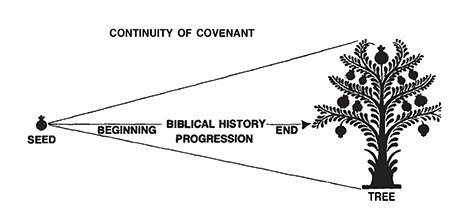Beating Around the Burning Bush

The Blindness of Paedosacramentalism
Leithart’s paper is not a New Covenant growth from glory to glory, but an Old Covenant journey from dust to dust.
The Question
My friend Peter Leithart’s paper Sacrifice and Worship After the Stoicheia is, as usual, carefully written and interesting to read, but I really do feel he has missed the point. Concerning the hermeneutical assumptions behind paedosacraments, he writes:
All Christians accept that the menu at Passover was different from that of the Supper, and baptism differs from circumcision because it does not involve a cut in the flesh and includes women. In the midst of these self-evident discontinuities, the paedo-arguments locate specific features of Old Testament rites that retain liturgical force. Paedo-arguments assume that we can determine which features are common to stoicheic rites and Christian rituals, and which are not.
For Baptists, I imagine, some of these assumptions look deeply suspect. From a Baptist perspective, it might well appear that paedo-arguments depend on adherence to ta stoicheia tou kosmou from which Paul says we have been liberated. Baptists will want to ask, Why should Israel’s regulations about access and inclusion regulate the church’s liturgy and sacraments?
Though Baptists are unusually too polite to express their disgust, paedobaptists can smell like Judaizers to a Baptist nose. As a convinced paedobaptist, I do not believe I exude the aroma of a Judaizer, but I acknowledge that paedobaptists have been neither consistent nor clear about the hermeneutical logic of their liturgical and sacramental theology. In this paper I attempt to assess that logic in the light of the New Testament’s own explicit appeals of stoicheic ceremonies.
Leithart’s paper is very much worth a read, but even within the limited scope of his helpful New Testament survey, he fails to identify any guiding principle that might help us define the extent of the discontinuity or continuity beyond a fuzzy observation concerning “access.”
…Hebrews 13 demonstrates that stoicheic regulations do not simply transfer to Christian worship after the stoicheia, but that passage also clarifies the character of the discontinuity. The Christian altar is not absolutely open. Those who refuse to leave the gates of the city have no share in the feast. But the difference between stoicheic and post-stoicheic religion is essentially a difference between exclusion and an inclusion, between a closed and an open gate, between a partial fast and a feast, between a divine No (with echoes of Yes) and an undiluted divine Yes.
He concludes with the statement that
Getting in step with “…the New Testament’s transpositions of stoicheic melodies is only the beginning of our labors.”
Does Jesus expect us to fumble around in the dark, as Leithart does, trying to figure out which parts of the Law apply to the Church and its worship, and then how they should be applied, or has He given us an overriding principle which not only explains the “internal logic” used by the New Testament writers, but enables us to make similar applications?
I find all this extremely frustrating for two reasons. Firstly, the answers which Leithart seeks are already built into the combined works of Jordan and Leithart, but they cannot see them because they will not allow the Scriptures to speak when it comes to the New Covenant sacraments.
Secondly, over the past few years, I have taken these aspects of the works of Jordan and Leithart and demonstrated very carefully and clearly how these aspects not only answer the questions Leithart asks in this paper, but also reveal the internal logic of the Bible as the key to these supposed “labors.” The “stoicheic melodies” are no work at all to figure out when one has not contorted the New Covenant to fit Abrahamic assumptions. Leithart already knows the tune, but he continually fails to apply it. (See Exposed to the Elements, Children of Heaven, Reading Galatians Backwards.) Not one of my Federal Vision friends has yet answered my objections — even though these objections point out inconsistencies within their own brilliant work — and after years of waiting for some definitive answers, I suspect this is simply because they “do not compute.” More than once I have had to point out that their responses were based on their own unproven assumptions, from under which I had just pulled out the rug. A short summary of the response of the best theological minds on the planet to my case is basically TILT. How can this be? The New Testament has to pass through an Abrahamic paradigm constructed solely on mistaken assumptions before it even gets into their brains. The answers are staring them in the face from the pages of their own writings but they simply cannot see them.
Perhaps the problem is that I am not working from baptistic assumptions with which they are familiar. I studied in the Jordan-Leithart-Wilson school of math, and I am trying to show them that their own algorithm leads to a very different conclusion than the one they continue to teach. Moreover, the fact that they are indeed half right is the reason my Federal Vision friends stink like Judaizers not only to baptists but also to fellow Reformed folk.
I have no social skills and can come across as impolite, so despite appearances I am not angry with them. I do see where they are coming from. I simply do not think they have gone far enough! (See Rise of the Uberbaptist.) If they choose to deal with my objections at some point, all they have to fight against is the cold, hard calculations of biblical logic. I have no denominational loyalties or career prospects to defend. I am not on anyone’s payroll. I just want them to show me their workings. Leithart promises to do so in this paper but merely ends with some hand waving. Unless there is a sequel planned, I cannot understand how any reader could be satisfied with this, but then neither paedobaptists nor baptists have done much about getting to the bottom of things, have they? FAIL.
The Answer
Jordan and Leithart both appreciated my book, Bible Matrix, since it systematized a lot of their own work, and seemed to be the best way to share it around in an introductory form. I went on to apply the same logic to Covenant Theology in Bible Matrix II, but the overall response did seem to be DOES NOT COMPUTE. These men are often too gracious and polite to tell me off, but for me the logic is everything. If my math is out, I would rather know. But you had better be able to show your workings. One comment that struck me was the friend who said, “How can you have such a dichotomous view of Covenant history?” In other words, how can there be such a great discontinuity between the Old Covenant and the New? Indeed, Ray Sutton’s book That You May Prosper, upon which I drew heavily, contains a diagram of Covenant history as a single tree.

Once again, because of the Abrahamic paradigm, the left hand does not know what the right hand is doing. Sutton rightly points out that Covenant cycles are repeated, with similarities and dissimilarities at each point, the greatest of these being the transition between the Old Covenant and the New. What both he and Leithart fail to give due attention to is the truth that the biggest change, the greatest dissimilarity, was the shift in focus from the fruit of the womb to the fruits of the Spirit, from sons of men to sons of God. This occurred at Pentecost, the day when the consuming fire of Sinai, the very presence of Yahweh in the burning bush, became an indwelling presence in each believer.
Since this shift is from access based on one’s first birth or tribal membership to access based upon ethical/spiritual conversion (the “second birth”), it radically reframes any discussion of “exclusion” and “inclusion.” It also shows that the exclusion/inclusion of the New Covenant sacraments is a fulfilment of the actual stoicheic boundary of the Mosaic Law (the Laver and the Levitical ordination and washings) and not of the social divide between Jew and Gentile in circumcision. The division between Jew and Gentile is gone. All that remains is qualification for mediatory (sacrificial) ministry, and once again, some of the statements made by Leithart in his book Priesthood of the Plebs support credosacraments rather than paedosacraments. He does not see this because he is blinded by his Abrahamic paradigm.
The biggest problem with the “Covenant theologians,” as I have written repeatedly, is that they believe there are people outside of the New Covenant, and baptism is entry into the Covenant. Nothing could be further from the truth. The maintenance of any kind of Covenant boundary is what smells of Judaism, and that smell is the smell of blood. Again, this is why paedobaptists struggle with the book of Galatians. They do not see that Paul is railing against something which they themselves are committed to: membership in Christ which can be inherited by proxy, that is, by heredity or some tribal or civic identity. The promises of God in Christ are for everyone on the planet, all bloods. That was the point of Pentecost. All are now under “Covenant obligation” (“repent and believe”) but only those who hear and respond in faith become members of Christ, with a new internal obligation: legal testimony in the Spirit.
So, what is the guiding principle here, the one which will make short work of Leithart’s imagined labors? The truth that Covenant history moved from external law to internal law. Leithart understands that ta stoicheia tou kosmou were something the people of God were under, and he is mistakenly looking for Christian versions of these things which we Christians must be under. But as in the article linked above, the entire point is that we are no longer under the sword; we are now the sword bearers. The true saint does not need to be coerced. He or she hears an exhortation and responds because deep answers unto deep. The voice that comes to us externally is echoed by the voice internally, and we respond in righteousness because there are now two witnesses. This exposes the redefinition of “saint,” “Covenant,” “church,” “regeneration,” “gift of the Spirit,” “salvation,” “conversion” and the rest by my Federal Vision friends for what it is: a big, blind stumble in the dark. Their Covenant theology is, at heart, a return to the elements of the earth: external law. Leithart’s paper is not a New Covenant growth from glory to glory, but an Old Covenant journey from dust to dust.
I appreciate very much the idea that we do have a task to carry out concerning the identification of tropes from the Old Covenant that we might understand the mind of God in Christ concerning our worship in the New. That is why those examples were given to us. But the failure to differentiate between a son of man and a Son of God, at the very outset, shows that these theologians have started off on the wrong foot and in the wrong direction. But they will not see.
If you would like to read more about “internal law,” here is a link to a chapter from my book, Sweet Counsel.

























